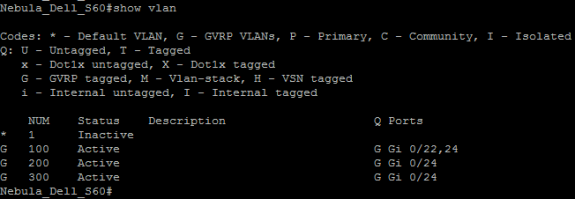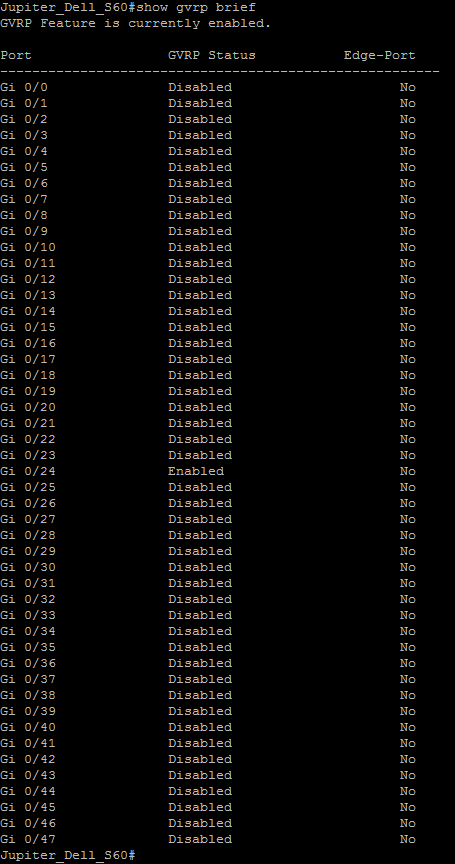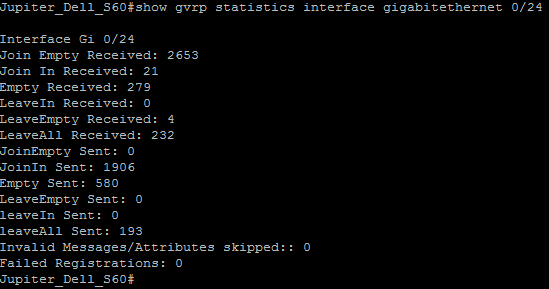GARP VLAN Registration Protocol (GVRP) is a standards-based protocol defined in the IEEE 802.1Q specification that provides for automatic VLAN configuration on switches. The Generic Attribute Registration Protocol (GARP) is used by switches supporting GVRP to register/de-register attribute values such as VLAN IDs between switches within the network. GVRP is the standards-based equivalent to Cisco’s Virtual Trunk Protocol (VTP). To read more about Cisco VTP, read my prior blog at networkpros.org. For this blog, I utilize 2 x Dell S60s [FTOS 8.3.3.8 ]and 1x Dell S50N [FTOS 8.4.2.7]. Below is the network diagram for this lab.
Before I start configuring the switches, some good and some not so good things to keep in mind:
– All VLAN ports being added to GVRP must be tagged.
– If using STP, GVRP will only function on ports in the forwarding state.
– VLAN name and description are not propagated – only the VLAN ID is.
– By default, VLANs created dynamically with GVRP exist only as long as the the device that the VLAN was created on keeps sending GVRP updates. For example, a reboot of a switch advertising VLANs would cause all the dynamic VLANs being advertised from that switch to disappear; of course, the same VLAN can be learned from multiple switches to provide for a backup in such a case.
– As with Cisco VTP, the dynamic VLANs learned with GVRP are not saved in NVRAM as static VLANs are.
– On Dell FTOS E-Series, C-Series, and non-S55/S60 S-Series switches, Per-VLAN Spanning Tree (PVST+) and MSTP is not supported while GVRP is used; if STP is required on these switches, RSTP can be utilized with GVRP. On S55 and S60 only, MSTP can be utilized while also using GVRP.
– There is no equivalent in GVRP to Cisco’s VTP transparent mode.
– One nice benefit of GVRP is that if the server NIC supports GVRP, it could automatically configure the access switch ports to be part of the correct VLAN based on server NIC config!
Below is the configuration for each of the switches. In this example, I supply all VLAN configuration (VLAN 100, 200, and 300) from the top switch, ‘Jupiter_Dell_S60’. The VLANs are then automatically created on the other two switches. Just for demonstration, I also configure VLAN 100 on the bottom switch ‘Zeus_Dell_S50N’ to demonstrate how a VLAN can be learned from multiple switches.
Jupiter_Dell_S60
– enable
– configure
– protocol gvrp
– no disable
– interface gigabitethernet 0/24
– switchport
– gvrp enable
– no shutdown
– exit
– interface vlan 100
– tagged gigabitethernet 0/24
– exit
– interface vlan 200
– tagged gigabitethernet 0/24
– exit
– interface vlan 300
– tagged gigabitethernet 0/24
– exit
– end
– write
Nebula_Dell_S60
– enable
– configure
– protocol gvrp
– no disable
– interface range gigabitethernet 0/22, gigabitethernet 0/24
– switchport
– gvrp enable
– no shutdown
– end
– write
Zeus_Dell_S50N
– enable
– configure
– protocol gvrp
– no disable
– interface gigabitethernet 0/22
– switchport
– gvrp enable
– no shutdown
– exit
– interface vlan 100
– tagged gigabitethernet 0/22
– end
– write
Once the configuration is complete, I can use the “show vlan” command as shown below on the respective switches to confirm successful GVRP configuration. Note, the ‘G’ character on the far left of some lines of the output designates that the VLAN was learned via GVRP.
Some additional commands as shown below can be used to help troubleshoot GVRP issues.
The “show gvrp brief” command displays GVRP status of each port.
The “show gvrp statistics summary” command displays a summary of all GVRP statistics.
Since this example has just one interface of ‘Jupiter_Del_S60’ enabled with GVRP, the “show gvrp statistics [interface]” command will produce the same results as the “show gvrp statistics summary” command.
Finally, there are three different modes of GARP VLAN registration available:
– Normal mode: trunk sends/receives/advertises VLAN information normally as expected.
– Fixed mode: allows for manual VLAN creation, prevents VLAN de-registration. and registers all VLANs advertised.
– Forbidden mode: prevents the port from dynamically registering and propagating VLAN information except for VAN 1 information. Forbidden mode is used when it is desired that the port not advertise or learn VLANs.
If desired, GARP timiers can be modified via the following commands in ‘config’ mode:
– Join: garp timer join
– Leave: garp timer leave
– LeaveAll: garp timers leave-all










 Twitter
Twitter LinkedIn
LinkedIn Youtube
Youtube RSS
RSS